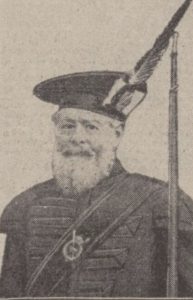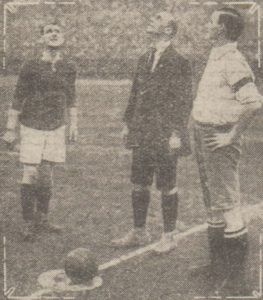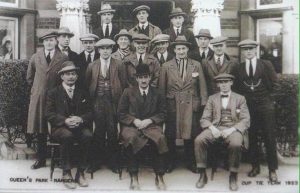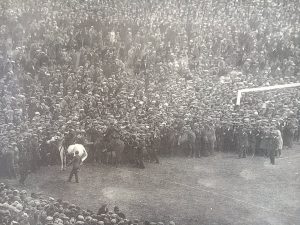By Vince Cooper
ON a bleak January day in 1922 a select group convened near the top of a hill in Middlesex. After a few preliminaries H.R.H. The Duke of York took a spade and cut out a neat square of turf. Less than a year and after 25,000 tons of concrete,1,500 tons of steel and 500,000 rivets had been used, the world’s finest sports stadium had been erected at Wembley. This monumental effort allowed the new stadium to host its first F.A. Cup final, a match that has become iconic in football history

Work on the Twin Towers
When the 1922-23 F.A. Cup got underway on 9 September 1922, the new Stadium was still mostly a hole in the ground. By the time 64 teams lined up for the 1st Round proper on 13 January 1923, things had begun to take shape and the famous Twin Towers were looming into view.

Goalkeepers in action in the 1st Round
1st Round
Midland League part-timers Worksop Town battled through the qualifiers to make it to the 1st Round. They had already seen off Grimsby Town and Chesterfield and were now given the task of travelling to White Hart Lane to face 1st Division Tottenham Hotspur.

Stout defending by Worksop Town at Tottenham.
The Londoners, winners of the trophy two years before and semi-finalists in 1922 were held to a shock goalless draw in front of 23,928 fans as Worksop, nine of whose players had been hard at work in the coal mines two days before, proved a match for their hosts. Writing in the Athletic News, ‘The Vagrant’ was full of praise for the visitors. ‘Let me pay tribute’, he wrote, ‘to as gallant a set of triers, of genuine, honest, whole-hearted workers as I have ever seen’.
The replay proved a different story. Worksop chose to relinquish home advantage and the rematch was played just two days after the first encounter. Spurs raced into a 5-0 lead inside 25 minutes and ran out 9-0 winners over their plucky but no doubt weary opponents.

1st Round attendances and receipts
Elsewhere in the 1st Round, Arsenal recorded a goalless draw at Liverpool. The Reds would go on to retain the League title and in the replay at Highbury they showed their class running out 4-1 winners. Another all-top flight clash took place at Villa Park where in front of a biggest-of-the-round crowd of 47,000 the Aston Villa players were ‘crippled’ and reportedly upset by the ‘vigorous methods’ of Blackburn Rovers who ran out 1-0 winners, the match decided by a penalty from veteran international winger Dicky Bond.

‘Charlton’s triumphant March’
Bolton Wanderers recorded a comfortable 2-0 win at Norwich whilst West Ham United, then of the 2nd Division also came through on the road edging past Hull City 3-2.
The surprise of the round came at Maine Road. Charlton Athletic, who had only been members of the Football League for 18 months and were struggling at the foot of the 3rd Division (South) scored a famous 2-1 victory over Manchester City with the winning goal coming from skipper Arthur Whalley – formerly of Manchester United.
The longest tie took four matches to decide. It was eventually won by Sheffield United who would go on to finish in mid-table. They eventually saw off 1st Division rivals Nottingham Forest who finished the season in 20th place, avoiding relegation by a single spot.
The first encounter took place in Nottingham on January 13th in front of a crowd of 24,700. The brilliance of 40-year-old home ‘keeper Sam Hardy, who had been a title-winner with Liverpool 17 years before, kept Forest in the game as the teams eventually settled for a goalless draw. So it was back to Bramall Lane for the replay. A crowd of 39,862 assembled for the second go, with most anticipating a comfortable home win. But again Hardy, ably assisted by Irish centre-half Gerry Morgan, kept the Blades at bay. In extra-time the visitors went close to pulling off a shock but outside-right Sid Gibson saw his shot, after a tremendous run, strike the crossbar.
The venue for the third clash was decided by a coin-toss. Forest were hoping to stage the match at Meadow Lane whilst United wanted to play at Hillsborough. It was back to Nottingham after Forest won the spin and after more than three-and-a-half hours of goalless football, the 17,483 witnessed a comparative deluge with two in the first six minutes. But after that defences took charge again and the teams finished level at 1-1. Just 24 hours later at Hillsborough a crowd of 31,982 saw the tie decided when Billy Gillespie’s second half strike sent United through.
Amateur side Corinthian entered the competition for the first time and were given direct entry to the first round. There they were drawn to play Brighton. Corinthian held their opponents to a 1-1 draw at the Goldstone Ground and did the same in the replay at Stamford Bridge before returning to the same ground for a third match and seeing their star ‘keeper Benjamin Howard Baker beaten just once, by Tommy Cook in front of a crowd of 43,760.

Tommy Cook
Cook had an eventful life with a tragic end.
A fine batsman for Sussex as well playing over 200 times for Brighton and winning an England cap against Wales in 1925. The goal at Stamford Bridge was one of 123 he got for Albion, setting a record that stands to this day.
Cook served in the Royal Navy in the 1st World War, winning a medal after saving a fellow shipmate’s life and then in the Royal Air Force in the 1939-45 conflict. There, he suffered severe physical and mental injuries after a training crash whilst seconded to the South African Air Force, spending six months in hospital. In 1950, he took his own life by overdosing on sleeping pills 10 days after his 49th birthday.

Lord Kinnaird
2nd Round
In all second round matches players wore black armbands to mark their mourning for Lord Kinnaird, former President of the Football Association and one of the greatest FA cup players of all time.

2nd Round attendances and receipts

Action from Stamford Bridge as Chelsea and Southampton clash in the 2nd Round
On the pitch there were more shocks.

The skippers toss a coin before the start of Charlton Athletic v Preston North End
Preston North End, the previous year’s finalists were knocked out as Charlton Athletic produced another upset, recording a 2-0 win whilst second-tier South Shields made further progress. After looking the better team in a goalless home draw they overcame Blackburn Rovers by a single goal in the Ewood Park replay
There were also wins for 2nd Division Bury and Southampton over top flight Stoke City and Chelsea respectively. The Saints came through 1-0 thanks to a Charlie Brown goal in the replay after a goalless draw at Stamford Bridge in front of 67,105 fans, the highest attendance of the round.

Stirring incidents in the 2nd Round
Holders Huddersfield also came close to leaving the competition. They were fortunate to claim a goalless draw at Millwall Athletic before winning the replay 3-0 whilst ‘Tich’ Handley of Tottenham Hotspur scored his second hat-trick in successive rounds. After nabbing three in the Worksop replay he repeated the feat to help his team overcome Manchester United 4-0.
Bolton saw off Leeds United 3-1 but had to come from a goal behind at half time. A brace from David Jack and one from Joe Smith saw them home. West Ham edged past Brighton, a Jimmy Ruffell goal providing a 1-0 in the Upton Park replay after the first match at the Goldstone Ground finished all-square at 1-1.
3rd Round

Part of the record crowd at The Valley
And so onto the third round – the last 16 in those days. 3rd Division (South) Charlton Athletic continued their impressive run seeing off West Bromwich Albion 1-0 – their third successive win over top flight opposition, and against three former holders of the trophy. Much-travelled Bert Goodman scored, as he had done in Charlton’s previous two matches and the vast majority of a then-record crowd for The Valley of 35,000 were sent home happy
Bolton were drawn to visit Huddersfield and after claiming a 1-1 draw at Leeds Road, they edged past their Yorkshire rivals 1-0 in the replay in front of over 61,000. Meanwhile West Ham saw off West Country rivals Plymouth Argyle 2-0 at Upton Park with goals from Billy Moore and Welsh winger Dick Richards who had joined the club from Sunderland and Wolves respectively during the previous summer.
The Hammers had begun the season poorly, losing seven of their first 13 matches in the 2nd Division. But Syd King’s men then went on a run 32 games with only one defeat which saw them rise up the table and put together their cup run.

Queens Park Rangers
Elsewhere previous giantkillers South Shields suffered their own shock when ousted by Queen’s Park Rangers of the 3rd Division (South) thanks to a brace from Dick Parker against his former club, whilst league-leaders Liverpool saw their double hopes end when beaten 2-1 at home by Sheffield United.

‘Moments of peril’
4th Round
The 4th Round (quarter-finals) matched up four teams from London with four from outside the capital. Three of the capital teams were drawn at home and all suffered single-goal defeats. Bolton travelled to The Valley and ended the run of Charlton Athletic in front of a second record crowd for the ground – this time 41,011 were present – thanks to a goal from David Jack whilst Queen’s Park Rangers and Tottenham Hotspur were knocked out by Sheffield United and Derby County respectively.

Quarter-final attendances and receipts
The tie between Southampton and West Ham United was even tighter. The teams met three times before a winner could be decided with the Hammers coming through 1-0 at Villa Park thanks to a goal from Billy Brown in the second replay. The teams had agreed to meet at Stamford Bridge but with a semi-final due to be played there the FA intervened and sent them to Birmingham where they attracted a crowd of 22,000.

West Ham United 1922-23
Semi-Finals
The semi finals matched Bolton Wanderers with Sheffield United at Old Trafford whilst Stamford Bridge was the venue for West Ham’s encounter with Derby County.
The Sunday papers gave their front pages over to news of the Boat Race in which Oxford, stroked by American W. P. Mellen, overcame Cambridge by three-quarters of a length.
There was still of room for football coverage elsewhere. A crowd of 72,000 at Old Trafford saw Bolton record another single-goal win, again thanks to David Jack, over Sheffield United. The Yorkshire team had gone into the match as favourites but an early injury to wing-half Jim Plant left them at a disadvantage and Jack’s goal, although said to be somewhat lucky, proved enough.

Billy Brown (on the ground) gives West Ham an early lead.
The game at Stamford Bridge providec a goal-fest and an upset. The 2nd Division Hammers took the lead after just three minutes and ran out 5-2 winners in front of a crowd of 50,795 thanks a pair of goals each from quarter-final hero Brown and Billy Moore and one from flying winger Jimmy Ruffell.

Wembley. Preparing the pitch
The Final
So, the stage was set for Wembley’s first-ever final. And Wembley was set too. After an amazing amount of work had been carried out in 15 months, the new Stadium was set to receive the large crowd expected for the big day. But nobody anticipated just how large that crowd would be.

The Big Figures in the Big Final
Sir Robert McAlpine, the contractors, handed the stadium over on 27 April, just 24 hours before the big match.

Wembley
On the big day thousands started making their way to Wembley from 10am on Saturday morning. Some had tickets, many didn’t. The official capacity of the new Ground was set at 125,000. It is said that over 300,000 turned up.

The Road to Wembley
The Athletic News on 30 April said: “We feared there would be some disappointments but no one could have anticipated that tens of thousands of people would swarm all over the playing pitch an hour before the kick-off was due, and that the ‘arrangements’ would be so crude as they were.

Fans make their own way in
“Persons who had not paid, men without collars and ties, and all sorts of folk invaded the highest priced seats, and some of those who had tickets were either shut out or did not reach the places allotted to them”.

’Billy’ in action
Chaos ensued and for a time it seemed it would be impossible to play the game. That it did go ahead can be put down to the efforts of the police, with Billy, a grey horse (or white as legend would have it) and P.C. George Scorey doing much to restore a semblance of order with help from the players of both teams.
The fault was not that of the FA. The stadium was run on the day by the officials of the British Empire Exhibition, owners of the stadium, and a lack of suitable fencing allowed thousands of fans without tickets to find a way in.

‘The goals in the Cup final with the human touch lines’
The match was eventually kicked off by West Ham’s Vic Watson 45 minutes late and with fans encircling the pitch along all four touchlines.

David Jack scores
After just two minutes West Ham half-back Jack Tresadern was entangled with the crowd after taking a throw-win. This left David Jack to, in the words of contemporary journalist ‘Tityrus’: “show his complete mastery by an adroit dribble in which his sidestepping, elusive body swerve and hopping over outstretched legs were most conspicuous”. He then unleashed a ‘rocket shot’ to fire Wanderers in front, the shot beating Hammers keeper Ted Hutton and apparently knocking a fan who was pressed up against the goal net unconscious.

Bolton keeper Pym punches clear
West Ham fought back and took the game to their opponents but Wanderers held on and in fact had the ball in the net again but Jack Smith’s effort was disallowed for offside.

West Ham on the attack
Referee David Asson, not doubt fearful of the problems that might be caused by getting the teams to and from the dressing rooms, turned them straight around at half time and immediately began the second period.
Eight minutes after the restart Scottish forward Jack Smith doubled Wanderers’ advantage when firing home from an acute angle after a fine run and cross from Welsh winger Ted Vizard.

The Bolton team show the trophy to Prime Minister David Lloyd-George
The second goal seemed to knock the stuffing out of the Hammers and they faded from contention with their Lancashire opponents content to sit back and hold on to their lead rather easily to claim the trophy for the first time.

The smiling faces of the Cup winners
West Ham would gain some consolation for their defeat when winning promotion as 2nd Division runners-up to Notts County but the honours on that madcap day and the place in history of being the first team crowned as FA Cup winners at the new Empire Stadium went to Bolton Wanderers.

